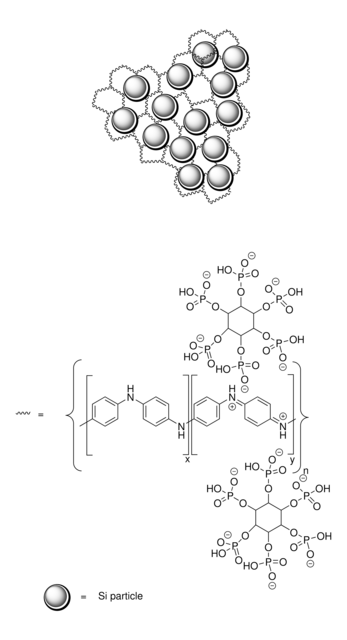633097
Silicon
nanopowder, <100 nm particle size (TEM), ≥98% trace metals basis
Sinonimo/i:
Silicon anode material
About This Item
Prodotti consigliati
Livello qualitativo
Saggio
≥98% trace metals basis
Forma fisica
nanopowder
Dimensione particelle
<100 nm (TEM)
P. eboll.
2355 °C (lit.)
Punto di fusione
1410 °C (lit.)
Densità
2.33 g/mL at 25 °C (lit.)
Stringa SMILE
[Si]
InChI
1S/Si
XUIMIQQOPSSXEZ-UHFFFAOYSA-N
Cerchi prodotti simili? Visita Guida al confronto tra prodotti
Categorie correlate
Descrizione generale
Applicazioni
Caratteristiche e vantaggi
- Superior Dispersion
- High Specific Surface Area
- Improved Mechanical Stability
- Enhanced Performance
Avvertenze
Warning
Indicazioni di pericolo
Consigli di prudenza
Classi di pericolo
Flam. Sol. 2
Codice della classe di stoccaggio
4.1B - Flammable solid hazardous materials
Classe di pericolosità dell'acqua (WGK)
WGK 3
Punto d’infiammabilità (°F)
Not applicable
Punto d’infiammabilità (°C)
Not applicable
Dispositivi di protezione individuale
Eyeshields, Gloves, type N95 (US)
Scegli una delle versioni più recenti:
Possiedi già questo prodotto?
I documenti relativi ai prodotti acquistati recentemente sono disponibili nell’Archivio dei documenti.
I clienti hanno visto anche
Articoli
Hydrogen is one of the most important resources in providing food, fuel, and chemical products for our everyday life. Sustainable catalytic hydrogen production from bioethanol has gained significant attention in recent years due to globally diminishing fossil fuel supplies, which have necessitated the search for new chemical feedstocks.
Recent demand for electric and hybrid vehicles, coupled with a reduction in prices, has caused lithium-ion batteries (LIBs) to become an increasingly popular form of rechargeable battery technology.
Silica is a very popular inorganic nanomaterial used in a wide range of applications including fillers for rubber, catalyst supports, separation media, carriers in food and agriculture, and abrasive/anticaking agents in cosmetics. It is also widely believed to be an important material for biomedical applications for following reasons.
Electrode Materials for Lithium Ion Batteries
Il team dei nostri ricercatori vanta grande esperienza in tutte le aree della ricerca quali Life Science, scienza dei materiali, sintesi chimica, cromatografia, discipline analitiche, ecc..
Contatta l'Assistenza Tecnica.


